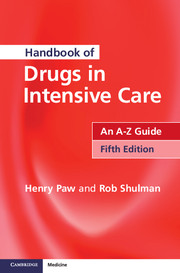Introduction
Published online by Cambridge University Press: 05 November 2014
Summary
Since the publication of the fourth edition in 2010, there have been several new drugs introduced to the critical care setting. This book has now been extensively updated. The main purpose of this book is to provide a practical guide that explains how to use drugs safely and effectively in a critical care setting. Doctors, nurses, pharmacists and other healthcare professionals caring for the critically ill patient will find it useful. It is not intended to list every conceivable complication and problem that can occur with a drug but to concentrate on those the clinician is likely to encounter. The book should be seen as complementary to, rather than replacing, the standard textbooks.
The book is composed of two main sections. The A-Z guide is the major part and is arranged alphabetically by the non-proprietary name of the drug. This format has made it easier for the user to find a particular drug when in a hurry. The discussion on an individual drug is restricted to its use in the critically ill adult patient. The second part is comprised of short notes on relevant intensive care topics. Inside the back cover is a colour fold-out chart showing drug compatibility for intravenous administration.
- Type
- Chapter
- Information
- Handbook of Drugs in Intensive CareAn A-Z Guide, pp. viiPublisher: Cambridge University PressPrint publication year: 2014



